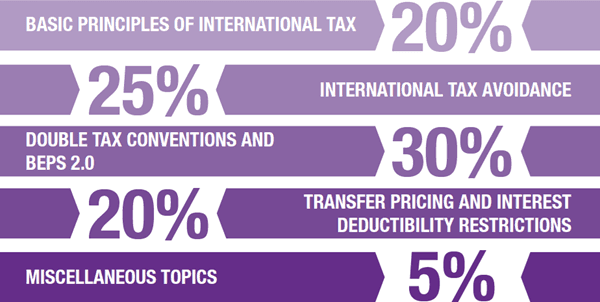Useful links
Useful links
Principles of International Taxation module
This module gives you the required breadth of knowledge, skills and understanding of international tax, based on the OECD Model Tax Convention and UN Model Double Taxation Convention, that you need to succeed in your career. Your learning will cover in detail key international tax issues, with particular emphasis on residence, double tax conventions and treaty interpretation, transfer pricing, the work of the OECD and the UN, and international tax avoidance.
Who is it for?
The Principles of International Taxation module is aimed at professionals around the world, particularly those advising or working with multinational corporations and private clients. It's suitable for senior level professionals, managers or those working towards a senior level.
What does it cover?

The approach to the assessment of the exam is holistic, enabling candidates to demonstrate and apply their knowledge from different perspectives. Candidates will be expected to demonstrate critical analysis and problem-solving skills in answering the different question types.
The 2025 syllabus for this module was the first to give equal prominence to the OECD Model Tax Convention and UN Model Double Taxation Convention, with awareness expected of the relevant Articles of both models. This change is designed to reflect the importance of both multilateral organisations in global tax governance. Candidates sitting the exam in 2025 will, however, be able to focus primarily on the OECD Model, should they wish to do so.
This exam consists of two parts. Part A consists of three essay-type questions worth 25 marks each. Part B consists of two scenario-type questions worth 25 marks each. Candidates are required to answer four questions in total.
Please note: from the 2025 exams, the number of questions available in Part A has been reduced from five to three. Part B remains unchanged from previous years' exams, with two scenario-type questions.
- Exam length: 3hrs 15mins
- Available in June and December
How it will benefit you
- Gain a robust understanding of theory coupled with practical application
- Build your confidence, skills and competencies to apply principles in your daily work
- Keep up with fast-changing developments in tax law, and stay ahead in your field
- Increase your employability with a qualification recognised around the world
Length of study
Approximately 140 hours of learning time is recommended to complete the Principles of International Taxation module. This may vary dependent on a number of factors including your background, knowledge and experience, and your study method.
How is it assessed?
- One exam consisting of two parts
- Questions designed to test your application of concepts to real world scenarios
- Employer-driven syllabus, with a professional focus
